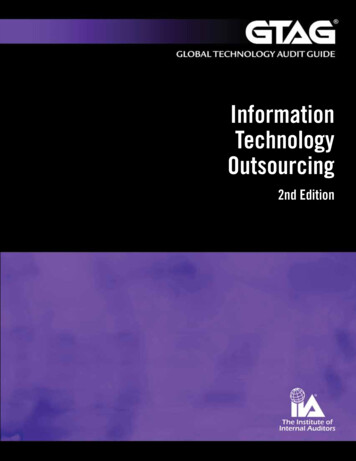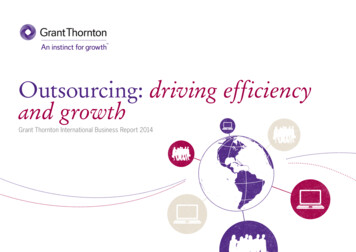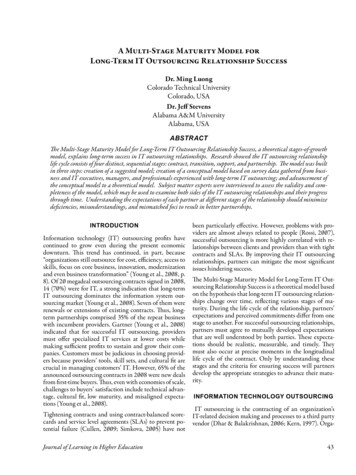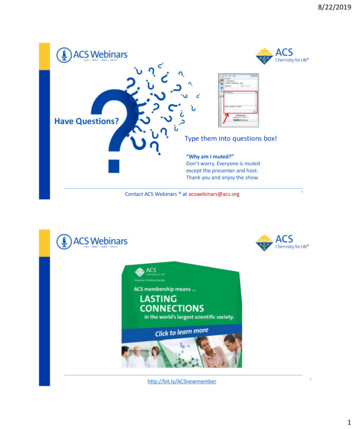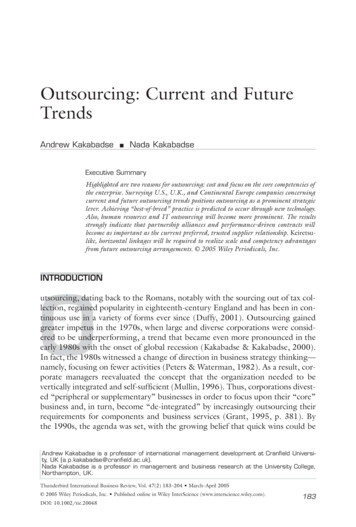
Transcription
Outsourcing: Current and FutureTrendsAndrew Kakabadse Nada KakabadseExecutive SummaryHighlighted are two reasons for outsourcing: cost and focus on the core competencies ofthe enterprise. Surveying U.S., U.K., and Continental Europe companies concerningcurrent and future outsourcing trends positions outsourcing as a prominent strategiclever. Achieving “best-of-breed” practice is predicted to occur through new technology.Also, human resources and IT outsourcing will become more prominent. The resultsstrongly indicate that partnership alliances and performance-driven contracts willbecome as important as the current preferred, trusted supplier relationship. Keiretsulike, horizontal linkages will be required to realize scale and competency advantagesfrom future outsourcing arrangements. 2005 Wiley Periodicals, Inc.INTRODUCTIONutsourcing, dating back to the Romans, notably with the sourcing out of tax collection, regained popularity in eighteenth-century England and has been in continuous use in a variety of forms ever since (Duffy, 2001). Outsourcing gainedgreater impetus in the 1970s, when large and diverse corporations were considered to be underperforming, a trend that became even more pronounced in theearly 1980s with the onset of global recession (Kakabadse & Kakabadse, 2000).In fact, the 1980s witnessed a change of direction in business strategy thinking—namely, focusing on fewer activities (Peters & Waterman, 1982). As a result, corporate managers reevaluated the concept that the organization needed to bevertically integrated and self-sufficient (Mullin, 1996). Thus, corporations divested “peripheral or supplementary” businesses in order to focus upon their “core”business and, in turn, become “de-integrated” by increasingly outsourcing theirrequirements for components and business services (Grant, 1995, p. 381). Bythe 1990s, the agenda was set, with the growing belief that quick wins could beOAndrew Kakabadse is a professor of international management development at Cranfield University, UK (a.p.kakabadse@cranfield.ac.uk).Nada Kakabadse is a professor in management and business research at the University College,Northampton, UK.Thunderbird International Business Review, Vol. 47(2) 183–204 March–April 2005 2005 Wiley Periodicals, Inc. Published online in Wiley InterScience (www.interscience.wiley.com).DOI: 10.1002/tie.20048183
Andrew Kakabadse Nada Kakabadseachieved by pursuing “core” strategies (Prahalad & Hamel, 1990).Many firms began reengineering, in effect embarking on a search fornew ways of organizing the various elements of work. Such “newbeginnings” promoted a rethink and radical redesign of business processes in order to achieve dramatic improvements in critical areas ofperformance such as cost, quality, service, and speed (Gamble, 1995).Many firmsFurther, with the proliferation and rapid pace of change of informabegan reengition technology (IT), IT became the most controversial part of theneering, in effect “outsourcing revolution” as numerous “mega-deals” worth over 1embarking on a billion produced below-expected results (Kakabadse & Kakabadse,2002a). Whether IT is a support service or more critical to the comsearch for newways of organiz- petitive position of many firms and should definitely be retained inhouse dominated the outsourcing debate among academics anding the variouspractitioners alike (Koudsi, 2001).elements ofwork.Some argue that IT is an activity that can inherently lead a firmtoward a dependency on its suppliers and therefore should only beoutsourced in parts, while others argue for fully realizing outsourcingbenefits (Carey, 1995).In order to capture the nature of the trends in outsourcing, attentionis given in this article to examining the reasons for outsourcing, thefunctions and activities outsourced, the nature of the sourcingarrangements, and the impact of outsourcing on employees. Further,the results of an extensive, international survey exploring current andlikely future trends in outsourcing are reported. It is concluded thatthe enhancement of core competencies will continue through greaterattention to the effective management of costs and through greaterefficient application of transactional skills in the day-to-day management of a variety of configurational arrangements. It is also forecastthat partnership arrangements will become more popular leading to“Keiretsu-like interactions” between purchasers and suppliers in orderto effectively realize the benefits to be gained from outsourcing.EMERGING TRENDS FROM THE LITERATUREThe more it became conventional wisdom that core activities shouldstay in-house, while noncore activities should be outsourced (Mullin1996; Prahalad & Hamel, 1990), the greater the attention that wasgiven to identifying what is a “core competency” (Insinga & Werle,2000). May (1998) suggests that the identification of core competencies requires assessment of the contribution of every activity to beundertaken in an organization to decide whether:184Thunderbird International Business Review March–April 2005
Outsourcing: Current and Future Trends it has a direct effect on satisfying customers’ needs; outsourcing would achieve comparable quality more cheaply; re-allocation of resources to other activities would earn a superior return; and other benefits might arise from outsourcing, such as: lower inventory cost, reduced management time, and improved production flow. outsourcinghas become bigbusiness, and itsSuch analysis was particularly prevalent in the pharmaceutical induseffective mantry, where the outsourcing of drug development now accounts for agement is critimore than 20% of such expenditures (Malek, 2000).cal to the futuresuccess of anAn International Data Corporation (IDC) analysis of the top 1,000organization.outsourcing deals in the year 2000 reveals contract expenditures ofalmost U.S. 56 billion. Larger contract sizes range from U.S. 58million to U.S. 7.5 billion, with most deals falling in between theU.S. 100 and U.S. 249 million range (IDC, 2000). Contracts ofsuch enormity introduce their own challenges, as according to arecent study, more than half of all outsourcing customers are dissatisfied and report having renegotiated a contract, and in nearlyone-quarter of the renegotiations, the suppliers lost that account(James, 2000).However, the undisputed truism is that outsourcing has become bigbusiness, and its effective management is critical to the future successof an organization (Kakabadse & Kakabadse, 2002a). As shown, thesize of outsourcing contracts has reached astounding proportions, aswitnessed by both Fiat’s U.S. 7 billion deal and NTL’s U.S. 2 billion deal with IBM’s Global Services (Bain, 2000; Heikkila, 2000;McCure, 2001). Thus, in the following section of the article, weexplore the trends in terms of reasons for outsourcing, whatareas/activities have been outsourced, outsourcing arrangements,and outsourcing impact on employees.Sourcing ReasonsAchieving economies of scale is highlighted as a critical reason foroutsourcing (Table 1). Recently conducted research examining theoutsourcing practices of numerous organizations concluded thatWestern companies outsource primarily to save on overheads throughshort-term cost savings (Klein, 1999). This finding has been echoedby other studies, which show that a prime driver for IT outsourcingis cost-effective access to specialized computing and systems development skills (Finlay & King, 1999).Thunderbird International Business Review March–April 2005185
Andrew Kakabadse Nada KakabadseTable 1. Trends in Outsourcing: An OverviewElementsCurrentFutureSourcing Reasons Cost DisciplineCapital AvailabilityCash FlowSpecialismAccess to Experts’ Skills Sourcing AreasSourcingArrangementsFunctional SpecializationIT MaintenanceApplications DevelopmentIT Business Processing DelineationEnhance Vertically IntegratedConfiguration Complex Cost of Data Storage Primary Vehicle for IT ServiceDelivery Noncore Function Single FunctionManufacturingTakeover of Existing AssetsUpfront PaymentsPerformance Improvement/CostReduction Vertically Integrative Thinking Diversified Corporation Single Supplier Entire Operation Handover Purchaser/SupplierSourcing Impacton Employees USA/UK/AustraliaEmploymentJob SecurityCorporate Career StructureLoyalty to OrganizationOrganization-Driven PerformanceMentality Organization Assesses TrainingNeeds Organization Provides Trainingand Development DifferentiationValue EnhancementCore CompetenciesAdaptation/Customer ValueRedirect Skills to HighValue-Adding AreasMarket ResponsivenessBusiness Process Management (BPM)Software as a Service (ASPs)Arbitrary DelineationPortfolio Relationships Cost per Month as Other Utilities Trading Medium Business Processes/IntellectualCapital Whole Process SMEs, Government Services Install and Run New Systems Per Use per Month Cost Reduction Irrespective ofPerformance Improvement Savings into R&D and SystemsInnovation Networked Enterprise SpecializedCorporation Best of Breed/Multiple Suppliers Different Suppliers Selected forEach Area of Specialization Consortia of Suppliers Joint Ventures, Shared Risk, Equity,Spin-offs, Partnerships Global/Sectoral Employability Career Resilience Self-Responsible Career Portfolio Loyalty of Self, Network Portfolio Personally Flexible and Self-DrivenPerformance Organization and/or IndividualProvides Tools for Assessing Needs Individuals Develop Their Skills toStay CompetitiveAdapted from Kakabadse and Kakabadse (2000).186Thunderbird International Business Review March–April 2005
Outsourcing: Current and Future TrendsEqually emphasized is that global competition has not only compelled companies to apply greater discipline over costs but also overproduct-to-market time cycles, resulting in smaller product and services portfolios and a loosening of the vertical links in the productionprocess (Quinn & Hilmer, 1994). Consequently, corporations havedivested activities that they regard as peripheral to their business and the trendfocused upon their “core” activities, which, for many, leads toincreased specialization, while still pursuing other value-adding being capturedobjectives (Willman, 1999). Such multiplicity has added a newis a movedimension to outsourcing, that of attempting to manage numeroustoward greaterand, at times, ill-fitting sourcing strategies (Cunningham, 2001). Abusiness focusreview of the literature emphasizes that now and into the future,through thedetermining what is core to the organization so that those processes development ofand activities considered peripheral can be passed over to an external business processservice provider will continue to be a prime consideration (Chalos &managementSung, 1998; Currie & Willcocks, 1997).(BPM) skills.While some consider core activities to be synonymous with core competencies, other writers consider that what is core and noncore is anacademic debate (Kakabadse & Kakabadse, 2000). The contrastingview put forward is that outsourcing decisions should be driven bythe purpose of the sourcing contracts, the relationships between thepurchaser and supplier, the leverage gained from outsourcing todetermine greater competitive advantage and the effective management of contracts, which, in turn, lead to the development of a newcluster of competencies (DiRomualdo & Gurbaxani, 1998). Hence,effectively managing outsourced relationships becomes a core competence itself (Alexander & Young, 1996). Poor management of outsourced relationships reduces the opportunity for realizingcompetitive advantage as the poorly developed service purchaser/service provider relationship inhibits fully leveraging the suppliers’ competencies (Costa, 2001).An additional trend identified is from outsourcing elements of theorganization, such as maintenance, data storage, or IT service delivery toward sourcing in or out more knowledge-based systems, suchas customer response handling, procurement, and even the skills ofmanaging critical processes (van Laarhoven, Berglund, & Peters,2000). In effect, the trend being captured is a move toward greaterbusiness focus through the development of business process management (BPM) skills (Hurley, 2001). On this basis, the delineationbetween what is critical or noncritical, or what is a part, a facility, anda component in contrast to a whole process, becomes arbitrary(Foremski, 1999).Thunderbird International Business Review March–April 2005187
Andrew Kakabadse Nada KakabadseSOURCING AREASThe area that has received substantial attention in the outsourcing literature has been IT (Hurley, 2001). The ever-greater emphasis ondiscipline over costs, the migration to flatter organizations, therequirement for greater flexibility, and rapid changes in technology e-commercehave promoted ever-greater IT outsourcing (Nairn, 1999). IT outhas been and is sourcing has been encouraged by the technological advancement inconsidered likely data storage capability, which has dramatically increased in qualityto continue defin- and significantly decreased in cost (Gartner Group, 1999). Thus,data storage services are being charged on a cost-per-megabyte-pering trading interms of “make, month basis, similar to payment for utilities as electricity and water,providing IT with more of a “commodity” status (Costa, 2001).buy, process,Further, companies, in their pursuit of competitive advantage, havesell” decisions.increased their reliance on external suppliers of information services.In fact, the International Data Corporation forecasts a global IT outsource market of more than 151 billion by 2003, focusing on processing services, such as payroll, claims, and credit card processing(IDC, 2000).In parallel, e-commerce has been and is considered likely to continue defining trading in terms of “make, buy, process, sell” decisions. Setting up a Web site for online sales can be expensive(Forrester Research, 1999). In-house expertise is required in server management, security, and related technical functions(Barthelemy, 2001). Further, such expertise is in short supply.Small and medium-sized enterprises (SMEs), unable to afford suchresources on a full-time basis, are increasingly turning to externalservice providers to host their Web sites (Murray & Kotabe, 1999).Even software suppliers themselves have entered into outsourcingarrangements with application service providers (ASPs) to supplyand manage applications remotely, charging a flat fee per user(Forrester Research, 1999).Partly because IT has a significant impact on the functioning of theorganizations and partly because of the ever-changing views of whatis core or noncore to the enterprise, the literature highlights the allembracing nature of outsourcing (Gupta, 2000). Under the umbrella of BPM, outsourcing has not only penetrated the SME and smallbusiness market but public services as well (Costa, 2001). The effectof deregulation, the creation of new agencies through quangos andthe vigorous application of “best value” have been profound influences on the previously vertically integrated public-service organizations (Halachmi & Montgomery, 2000). Governments in the188Thunderbird International Business Review March–April 2005
Outsourcing: Current and Future TrendsUnited Kingdom, the United States, Canada, Australia, and NewZealand, in particular, have pursued best value with zeal in order todemonstrate continuous improvement in services and, as such, havealtered the configurational profile of government organizations. Thegrowth in horizontal linkages between public-service agencies andprivate-sector suppliers has been substantial. One consequence ofgovernment-driven outsourcing, however, has been the decline of Most partnershiparrangements,business opportunities for small to medium-sized IT firms. Stronglyinfluenced by the potential for cost savings through the ever-greater whether flexiblyapplication of IT, greater economies of scale are purportedly defined or moreachieved through outsourcing with large suppliers (Lavelle,formal, involveKrumwiede, & Sheu, 2000). In Australia, for example, organizations shared risk andsuch as IBM and EDS are reported as the prime suppliers of outbenefit.sourcing services (Costa, 2001). The opponents of best value andhuman rights activists fear that such developments are now placingthe large providers in a position of almost acting as governmentitself, or at least, as unduly influencing government (Kakabadse &Kakabadse, 2002a).SOURCING ARRANGEMENTSThe scope of emerging arrangements between host and suppliers isextensive (Murray & Kotabe, 1999). At one end are short-term contracts designated to encourage flexibility. At the other exists full ownership of and/or merger between purchaser and providers.Alternative arrangements lie in between, such as partial ownership,joint developments, retainers, other long-term contracts, relationships with trusted suppliers, single contracts, multiple vendor contracts, joint ventures, individual and joint venture spin-offs,consortia, and shared-service consortia (Domberger, 1998).The emergence of partnership or alliance arrangements as alternatives to the more popular project-based contracts, which are usuallyshorter, single contracts with preferred, trusted suppliers, is considered to provide a closer level of interaction between client andprovider. Most partnership arrangements, whether flexibly definedor more formal, involve shared risk and benefit (Miles & Snow,1997). The assumption is that any single vendor does not possessworld-class capabilities in all areas of business and, hence, the needto embark on selective outsourcing with multiple vendors. Evensuch relationships vary, ranging from one vendor acting as primecontractor to all or most of the vendors enjoying equal status(Gupta, 2000).Thunderbird International Business Review March–April 2005189
Andrew Kakabadse Nada KakabadseA further outcome of contract innovation has included joint ventures, cross equities, and franchises, typified by the Virgin organization, as their interests include retail, travel, soft drinks, music,financial services, and other business ventures (Nee, 1999). TheVirgin practice has been to provide the brand name and marketingcapability while the other joint venture partners provide specialist serPractices thatvices, production facilities, and capital. A further alternative arrangeenhance informent is that of spin-offs, whereby an internal cost based activity isfully exposed to market forces (Chalos & Sung, 1998). In effect, amation sharingand protect key cost center is turned into a separately managed profit center. A considerable number of examples exist of firms developing world-classcompetenciesaid the manage- competencies that are tangential to the parent’s traditional line ofment of strategic business. General Motors’s spin-off of EDS and Mercedes Daimler’sIT-based service company of Debis are two such examplesalliances.(Blumenstein, 1997; Cusumano & Takeishi, 1991).Even looser outsourcing arrangements are alliances, consortia, andshared-service agreements. Strategic alliances are seen by some as an“in vogue” arrangement, because of the capacity to bring togetherpartners who hold differing and possibly conflicting objectives(Inkpen & Beamish, 1997). Whatever the reasons for the alliance,transparency between the partners is considered to be vital. Practicesthat enhance information sharing and protect key competencies aidthe management of strategic alliances (Hurley, 2001).A further form of strategic alliance is consortia-based outsourcing, orsourced-service consortia. NV Philips, the global Dutch electronicscompany, set up a joint venture, BSO-Origin, involving equity sharesand seats on the management board, with BSO Beheer, the Dutchsoftware enterprise, in order to outsource its applications development function (Klein, 1999). Later, the parent, Philips, and BSOOrigin worked together to deliver services in the open market and, asa consequence, gained the cooperation of further software serviceproviders, ultimately emerging as a sourced-service consortia enterprise. Overall, whatever form of arrangement is in vogue, the reported trend is less toward the takeover of existing assets by the supplierto the installation and running of new or alternative systems withconsequent changes in the structure of payment for services(Teresko, 1999). The shift is from upfront payments to “pay as yougo,” or more properly, payments per month. Such emerging arrangements are considered as combining cost reduction with performanceimprovement and R&D and systems innovation. The shift is fromvertically integrative thinking to the networked enterprise that provides innovative, best-of-breed services (Currie & Willcocks, 1997).190Thunderbird International Business Review March–April 2005
Outsourcing: Current and Future TrendsOUTSOURCING IMPACT OF EMPLOYEESThe IT revolution and the ever-greater requirement by companies todifferentiate themselves from competitors through a variety of means,including how to simultaneously address both cost and service-qualityadvantages, have dramatically affected the shape of jobs and promoteda redesign in the way work is structured (Richbell, 2001; Sparrow, An emerging perspective is that2000). Job-based flexibility has now become a norm. Large enterprisemployees noes in the developed and emerging economies are increasingly adoptinglongerrespect orlimited-term contracts, associate-like relationships, and home-basedeven desire ateleworking as standard contractual relationships with employeessupportivesocial(Standen, Daniels, & Lamond, 1999). However, the advantages arenot all one-way, as the individual is also considered to benefit from the contract betweenmore flexible arrangements, allowing for greater disposable time. In the themselves andtheir employer.European Union in 1998, there were 1.1 million people, approximately 0.8% of the workforce, employed according to such arrangements, and by the year 2000, this figure was estimated to stand at 4.4million people, or 3.1% of the workforce (Tregaskis, 1999). Further,both private-sector and public-service enterprises are increasinglyadopting part-time, temporary, casual, and fixed-term contractualarrangements as a means for securing both cost advantage and laborflexibility (Mishra, Spreitzer, & Mishra, 1998; Shelgren, 2000). Sucharrangements reflect a change of understanding in the relationshipbetween employee and employer—namely, from job security inexchange for “loyalty” to one of performance for reward (Tyson &York, 2000). The pay-for-performance and career-resilience perspectives capture the change of heart from reliance on the employer to provide developmental opportunities to the employee attending to his/herown training and career progress. An emerging perspective is thatemployees no longer respect or even desire a supportive social contractbetween themselves and their employer. In effect, maintaining employee commitment is “all but gone” (Kakabadse & Kakabadse, 2000)!Pursuing the trends identified in the reviewed literature, the following section presents the findings from a recent survey examining thereasons for outsourcing, the areas/activities that have been outsourced, outsourcing arrangements, and the impact of outsourcingon employees.THE SURVEYA survey of U.S., U.K., and continental European enterprises acrossa wide range of sectors, such as financial services (e.g., banks, insurThunderbird International Business Review March–April 2005191
Andrew Kakabadse Nada Kakabadseance organizations, investment funds), IT/telecommunications, supply chain, logistics, and pharmaceuticals/chemicals, was undertaken.The study was pursued in two stages. Semistructured, face-to-faceinterviews with 50 CEOs, general managers, directors, and managingdirectors (MDs) were conducted in order to identify key trends andcurrent critical issues in outsourcing. The learning from these interIn terms of cur- views was utilized in drafting a questionnaire examining current andrent practice,future outsourcing trends. The validated instrument was distributedamong large and medium-size enterprises. Seven hundred and fortyaiming toseven organizations participated in the survey. The greater majorityachieve bestof the respondents held senior manager positions, either as seniorpractice whilegeneral managers or as executive directors and nonexecutive boardattempting tomembers (Kakabadse & Kakabadse, 2002a). Although the pattern ofenforce appropriate cost disci- responses varied across the sample, no statistically significant trendsplines and con- across sectors or across functional responsibilities emerged. Thus, thereported results capture the critical significant trends to havetrols scoreemerged across the whole sample population.closely.SURVEY RESULTSFor us, outsourcing is the process whereby noncompetitive functions and activities are combined with the same functions of otherfirms to gain economies of scale. To us, outsourcing brings benefit by removing noncompetitive activities from our organizationand pooling them with other organizations to gain economies ofscale that would never be achievable if the functions were maintained internally.(Senior Executive, Financial Sector)Sourcing ReasonsThere is an economic case for outsourcing. We realize economiesof scale. We also put market forces into play, which require organizations to make a fundamental reappraisal of their activities. Forthe outsourced activities, the organization knows what they aregetting for their money and we can monitor performance againstcost. For the service provider, that is their core business.(General Manager, Financial Services)Distinct clusters of reasons emerge for pursuing outsourcing now andinto the future (Figure 1). In terms of current practice, aiming toachieve best practice while attempting to enforce appropriate cost disciplines and controls score closely. Further, but not quite as highlyrated, are service quality closely ranked with focusing on better leveraging the core competencies of the organization. A third cluster ofreasons for undertaking outsourcing is identified and includes issues192Thunderbird International Business Review March–April 2005
Outsourcing: Current and Future TrendsFigure 1. Outsourcing PurposeAdapted from Kakabadse and Kakabadse (2002a).such as gaining access to new technology and skills that were notavailable in the organization, reducing headcount, enhancing theorganization’s capability to develop new products and services, andreducing capital costs.In terms of predicted future reasons for outsourcing, achievingbest practice is identified as critical. In support of striving for bestpractice, the adoption of new technology through best-in-classsuppliers while maintaining strict control over costs emerges as aclose second.From there on in, a number of different reasons closely cluster,emphasizing the need for further enhancement of capability withinthe organization. Improvements in service quality, a continuedemphasis on the core competencies of the organization, and theenhancing of the firm’s product/service portfolio are the areas seenas important for improving the organization’s capability to differentiate and gain advantage. As is the case currently, monitoring andenhancing cost disciplines through various means is likely to continue into the future. The one difference to emerge between currentand future reasons for outsourcing is that greater priority is likely tobe given to the sourcing of new technology and related skills. No significant response was received concerning the spinning off of theThunderbird International Business Review March–April 2005193
Andrew Kakabadse Nada Kakabadsenoncore parts of their organization in order to improve the level ofprofitability of the host organization. The survey results highlightthat now and into the future as much attention will be given toreducing costs as to strategically focusing the organization on gaining greater competitive advantage. The critical difference is thedegree of utilization of technology.SOURCING AREASWe have outsourced all of our noncore activities. There are onlya few sacrosanct activities that we do not consider for outsourcing, such as strategy planning. But then again, that is today,tomorrow we may start debating it.(IT Director, Utilities)In contrast to the attention given to IT outsourcing in the literature,basic services (canteen facilities, office services), human resources(HR) activities, and IT-related activities and processes, in that order,are the areas currently given greatest attention in terms of outsourcing (Figure 2).Figure 2. Business Processes/FunctionsAdapted from Kakabadse and Kakabadse (2002a).194Thunderbird International Business Review March–April 2005
Outsourcing: Current and Future TrendsThe reverse is predicted for the future, whereby IT services and HRprocesses and activities, in that order, are likely to receive the greatest attention. The survey respondents indicate that IT-based activitiesand services will continue to be a major focus of outsourcing due toever more rapid advances in technology. As additional IT-based innovation becomes commercially available, IT outsourcing will continue.In terms of HR, the increased use of Internet-based technology— high levels ofnamely, information publishing, database enquiry, employee-based HR outsourcingHR transactions, and HR workflow—makes these activities primeactivity arecandidates for outreaching. How much and what other activities are expected to conoutsourced within the HR function depends on each senior executinue, but for ative’s view of the values of elements of the HR function. However,limited period.once the objectives of HR outsourcing have been achieved, humanresources systems and processes will no longer be a prime target foroutsourcing. Hence, high levels of HR outsourcin
current and future outsourcing trends positions outsourcing as a prominent strategic lever. Achieving "best-of-breed" practice is predicted to occur through new technology. Also, human resources and IT outsourcing will become more prominent. The results strongly indicate that partnership alliances and performance-driven contracts will
